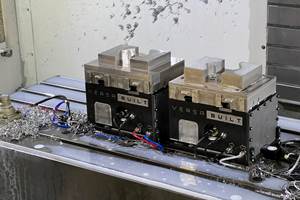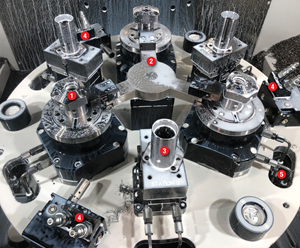Special Chucks Or Special Jaws?
Gripping difficult parts for turning operations sometimes requires something other than a standard chucking solution. The question is: Should you go to a special-purpose chuck, or can a tailored set of top jaws do the job?
Share







Autodesk, Inc.
Featured Content
View More


ECi Software Solutions, Inc.
Featured Content
View MoreSome turned parts are just tough to grip. They aren't round. They deflect. Their surfaces are irregular or inconsistent, and sometimes both. The features to be turned or bored are not centered on the workpiece.
These and many other workholding problems can be solved quite nicely with specially made chucks if you have enough volume to justify the cost and enough time to get the chuck designed and built. It's not the easiest way to go, but a highly optimized workholder will be the result. Or, with less time and money, you can have just special top jaws made. While that approach is more expeditious, it may come at a cost of reduced production efficiencies through necessarily more conservative cutting.
What's the best solution? Unfortunately, there's no easy answer because so much depends on the specific application. But here are some factors to consider that should help you begin to evaluate whether special chucks, or special jaws, have a place in your shop.
Top Jaws--More Versatile Than You Might Expect
No doubt, quite a large number of contoured or irregular parts can be held with more "standard" approaches, such as soft jaws bored to increase surface contact and support. Soft jaws have their limitations, though. Wear life is obviously a factor, and typically the added grip provided by hardened jaw serrations will be sacrificed. Unless the chuck is very accurate, typically they'll have to be rebored with each setup.
Special top jaw systems from a number of vendors can provide an answer to these limitations, as well as provide a relatively quick changeover from standard chucking to special-purpose functions. Some of the options include:
- Collet pad top jaw systems can convert standard through-hole chucks to hold small bar and tube stock.
- Compensating jaws provide enough play to conform to the surface irregularities of forgings and castings. A positive part reference, such as a fixed center or locator at the face of the chuck, can be used as a positioner for a required workpiece datum.
- Swivel-type jaws each are set on a pin (parallel to chuck center line) to provide six-point contact (on a three-jaw chuck) around the periphery of a part. They're useful on tube stock or other workpieces that tend to deflect under jaw pressure.
- Draw-down jaws have hardened, wedge-like serrations which, as they penetrate the part, mechanically draw it toward the chuck face.
- Nesting jaws for a two-jaw chuck provide a stationary upright stanchion in place of one jaw, which serves as the workpiece nest and location reference, while the other jaw functions as a single clamp to hold the piece in position.
- Equalizing jaws provide a rocker action to compensate for draft angles or other tapers in the ID of the workpiece. n Independent adjustable jaws compensate for workpieces, such as forgings or castings, that vary from lot to lot. A feature allows adjustments to the clamping position in relation to part forms that may not be consistent and need to be shifted.
- Stanchion/modular insert jaws are designed for family-of-parts production--for example, a range of brake cylinders, where modular locator inserts are used to establish proper center lines for each bore position.
- Shuttle-type container systems use an independent "clamping box" to hold the workpiece. The part is first mounted in this workholder, generally secured by some sort of swing-shut or squeeze-clamp arrangement, and then the entire workholder is chucked on the machine. This method is good for very difficult-to-hold parts, and it can be used to run the part across several different machines with a single gripping.
There are other examples as well. But the point to remember is that a host of top jaw options can be applied to standard chucks to solve very special problems. That's not to say these are off-the-shelf solutions. Chuck jaw suppliers often still will need prints and sample parts to engineer a solution. But they'll be able to do the job in a fraction of the time and expense of building a special chuck from scratch.
A general rule of thumb is that it takes about 14 to 18 weeks to build a special chuck, and fabrication of its jaws may add still more time to the cycle. An average leadtime for just special jaws runs between four and six weeks. As for cost, special jaws should not be more than 30 percent of the price of a special chuck. But don't expect a nominal charge either. For reference, a reasonably complicated special chuck may run some $15,000 to $20,000. A special jaw set for the same part might run between $2,000 and $4,000. This is but one example, however, and the costs associated with any given application really depend on the part.
The Best Chuck Possible
Lest we paint the top jaw option a little too brightly, shops should recognize that this, like any other production trade-off, has its costs. Depending on the volume, the most significant costs may have to do with slower production rates due to a less-than-optimum workholder. If lots are small, the cycle time issue obviously gives way to an emphasis on setup, which we'll get to in a moment. But as volumes increase, the cost of overly conservative cutting processes can grow very large indeed.
Why are special chucks more productive? Special top jaw solutions are built on top of the chuck. That means the workpiece center of gravity typically will be farther from the face of the chuck, or will require top jaws of greater mass, or both. Both result in the loss of grip force, but for different reasons.
As the workpiece moves out from the chuck face, static gripping force declines proportionately. In more extreme cases, this loss may be as much 20 to 30 percent. Also, if the jaws have to reach too far for the workpiece, heavy clamping pressure may result in jaw yield and the further loss of gripping power, as well as unwelcome internal forces in the chuck that can reduce service life.
The heavier the top jaws, the greater the dynamic loss of gripping power due to centrifugal force. The largest factor is speed alone. But the combination of the mass of the jaws and their distance from the center of rotation also can be very significant. It's not uncommon for a chuck to lose 20 percent or more of its dynamic holding power when a light set of standard jaws is replaced with a heavy complement of special top jaws. Or put another way, a chuck that is supposed to maintain a given clamping power at 2,000 rpm might now only hold that same power at 1500 rpm. (These losses have to be balanced, however, with the greater surface contact--and consequently, better holding power--that is generally the objective of a special top jaw system to begin with.)
With a special chuck, no such compromises may be necessary. These and other problems can be addressed more readily because the specific workpiece requirements can be designed into the chuck rather than on top of it. Workpieces can be drawn close or even into the chuck. Centrifugal forces as well as out-of-balance conditions can be offset. Workpiece deflection and vibration can be neutralized. Bottom line, with an optimized workholder, machining routines can be more aggressive--resulting in shorter cycle times and maybe more consistent quality as well.
And so the issue returns to whether the cumulative cycle-time savings brought about by a specially designed chuck are sufficient to justify its higher cost.
The Bigger Picture
At least, that's a usefully simple way to look at the issue. But there are still other parts of the equation, not the least of which is setup. Changing over just to special jaws requires, well, just a jaw change. In some cases it's even possible to serve special ap-plications with quick-change chucking systems, though that's more the exception than the rule. Still, the time required to change chuck jaws is generally far less than changing entire chucks, and that should be factored into the decision to go one way or the other.
The state of the production equipment is also important. An old, low-powered, or low-speed lathe may not be able to deliver the production levels a special chuck is capable of achieving. On the other hand, a superbly appointed turning center may go way underutilized when the workholder is not up to making the most of that substantial capital investment. In either case, matching the capabilities of the chuck to those of the machine is equally relevant. Don't forget, too, the safety considerations. Going for that last ounce of production is foolhardy if it imperils the operator, no matter how inadvertently.
Service life is another consideration. Many chuck manufacturers go to great lengths to ensure that their standard chucks are designed in such a way that parts wear evenly and in a predictable manner to offer very long life, so long as the chucks are well maintained. Building special applications on top of these standard chucks can sometimes disturb that delicate balance by introducing internal forces unanticipated in the original design--forces that may well result in reduced life. That factor, like just about everything else here, is entirely application dependent, and just about impossible to predict in any given case. Regardless, it should come as little surprise if a standard chuck succumbs a bit early under the pressures of special top jaw applications.
Figuring It Out
Rather than having a vendor make special top jaws, many shops elect to make them in house. There's nothing wrong with that, but it is important that do-it-yourselfers apply a sound methodology for analyzing job requirements because the selection, installation and qualification of the jaws will have a direct bearing on the success or failure of the machining application.
As such, a good top jaw analysis would have to include a solid understanding of the machining forces and/or any external loads imposed on the workpiece during the machining process. It also will require an understanding of how these forces effect the top jaws, and other system components--factors that can be determined by calculation, test data, and experience with other like applications. And finally, a properly installed set of top jaws should be qualified in terms of accuracy and precisely formed to fit the workpiece because that fit is paramount to achieving the best grip.
While this is a decidedly unscientific number, in something like 60 percent of the special applications, you can probably get by with just a specially engineered set of top jaws. For many shops, that may be improvement enough. But if the volume is there, and you're looking to fully optimize production, consider going to a chuck designed specifically for the rigors of the job.
Related Content
Using Jaws as Grippers Enables Flexible, Low-Cost Automation
VersaBuilt’s automation systems significantly boosted Innovative Fabrication’s revenue. In return, the shop has helped VersaBuilt optimize its products.
Read MoreParts and Programs: Setup for Success
Tips for program and work setups that can simplify adjustments and troubleshooting.
Read MoreShop Doubles Sales with High-Mix, Low-Volume Automation
Robots with adaptive grippers have opened entire shifts of capacity to high-mix, low-volume shop Précinov, doubling its sales.
Read MoreMachining Vektek Hydraulic Swing Clamp Bodies Using Royal Products Collet Fixtures
A study in repeatable and flexible workholding by one OEM for another.
Read MoreRead Next
Registration Now Open for the Precision Machining Technology Show (PMTS) 2025
The precision machining industry’s premier event returns to Cleveland, OH, April 1-3.
Read More5 Rules of Thumb for Buying CNC Machine Tools
Use these tips to carefully plan your machine tool purchases and to avoid regretting your decision later.
Read MoreSetting Up the Building Blocks for a Digital Factory
Woodward Inc. spent over a year developing an API to connect machines to its digital factory. Caron Engineering’s MiConnect has cut most of this process while also granting the shop greater access to machine information.
Read More










































